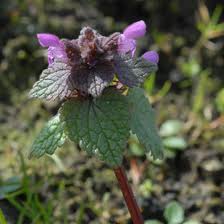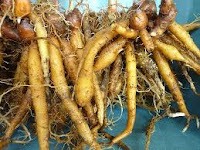The yellow dead nettle is one of the Archangels of the old herbalists and is a close relative of the white dead nettle and the purple one. Like the others this one has hollow stems and is not related to the common stinging nettle. The dead nettles are so-called because they don’t have the ability to sting. In Romania
Nicholas Culpeper writing in his 17th century herbal describes them thus:-
“Yellow archangel is like the white in the stalks and leaves; but that the stalks are more straight and upright, and the joints with leaves are farther asunder, having longer leaves than the former, and the flowers a little larger and more gaping, of a fair yellow colour in most, in some paler. The roots are like white, only they creep not so much under ground.”
 They are European natives and are members of the mint family of plants, the Lamiaceae or Labiatae family; as such they are related to marjoram, basil, Holy basil, oregano, savory, thyme, marsh woundwort, lavender, lemon balm, as well as bugle, motherwort, self-heal, catnip, the chaste tree, ground ivy, Jupiter’s sage, wall germander, Fragrant premna and hyssop.
They are European natives and are members of the mint family of plants, the Lamiaceae or Labiatae family; as such they are related to marjoram, basil, Holy basil, oregano, savory, thyme, marsh woundwort, lavender, lemon balm, as well as bugle, motherwort, self-heal, catnip, the chaste tree, ground ivy, Jupiter’s sage, wall germander, Fragrant premna and hyssop. As with the other dead nettles they have been used in European folk medicine for centuries and in Romania
 The crushed leaves are said to be wonderful healers of sores and ulcers, according to Culpeper, although they don’t smell very pleasant. In fact the Greek name for this genus, galeobdolon comes from gale meaning weasel, and bdolo which means an unpleasant smell or stench. Lamium means mint in Latin. Because of this odour, it is best not to eat them but to stick to one of the other Archangels or a stinging nettle.
The crushed leaves are said to be wonderful healers of sores and ulcers, according to Culpeper, although they don’t smell very pleasant. In fact the Greek name for this genus, galeobdolon comes from gale meaning weasel, and bdolo which means an unpleasant smell or stench. Lamium means mint in Latin. Because of this odour, it is best not to eat them but to stick to one of the other Archangels or a stinging nettle. To quote Nicholas Culpeper the Archangels were used for different ailments, although he states that they have much the same medicinal properties.
 ““Virtues and use. The archangels are somewhat hot and drier than the stinging nettles, and used with better success for the stopping and hardness of the spleen than they, by using the decoction of the herb in wine, and afterwards applying the herb hot into the region of the spleen as a plaister, or the decoction with spunges. Flowers of the white archangel are preserved or conserved to be used to stay the whites, and the flowers of the red to stay the reds in women. It makes the head merry, drives away melancholy, quickens the spirits, is good against quartan agues, stancheth bleeding at mouth and nose, if it be stamped and applied to the nape of the neck; the herb also bruised, and with some salt and vinegar, and hog-grease, laid upon an hard tumour or swelling, or that vulgarly called the king's evil, do help to dissolve or discuss them; and being in like manner applied, doth much allay the pains, and give ease to the gout, sciatica, and other pains of the joints and sinews. It is also very effectual to heal green wounds, and old ulcers; also to stay their fretting, gnawing and spreading. It draweth forth splinters, and such like things gotten into the flesh, and is very good against bruises and burnings. But the yellow archangel is most commended for old, filthy, corrupt sores and ulcers, yea, although they grow to be hollow, and to dissolve tumours.”
““Virtues and use. The archangels are somewhat hot and drier than the stinging nettles, and used with better success for the stopping and hardness of the spleen than they, by using the decoction of the herb in wine, and afterwards applying the herb hot into the region of the spleen as a plaister, or the decoction with spunges. Flowers of the white archangel are preserved or conserved to be used to stay the whites, and the flowers of the red to stay the reds in women. It makes the head merry, drives away melancholy, quickens the spirits, is good against quartan agues, stancheth bleeding at mouth and nose, if it be stamped and applied to the nape of the neck; the herb also bruised, and with some salt and vinegar, and hog-grease, laid upon an hard tumour or swelling, or that vulgarly called the king's evil, do help to dissolve or discuss them; and being in like manner applied, doth much allay the pains, and give ease to the gout, sciatica, and other pains of the joints and sinews. It is also very effectual to heal green wounds, and old ulcers; also to stay their fretting, gnawing and spreading. It draweth forth splinters, and such like things gotten into the flesh, and is very good against bruises and burnings. But the yellow archangel is most commended for old, filthy, corrupt sores and ulcers, yea, although they grow to be hollow, and to dissolve tumours.”We now have scientific evidence that the dead nettles or Archangels do indeed have different properties.















































